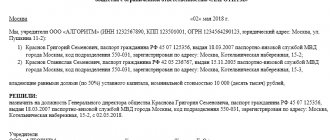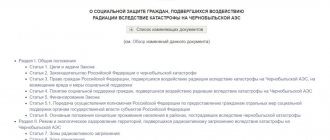Requirements for the content of the decision of the sole founder of the LLC
Let's consider the design of each of the elements of the solution in more detail, using the example of the abstract Rick LLC, which will be opened in Moscow.
A cap.
- the word “Solution” located in the middle of the document and written with a capital letter;
- the text of “the sole founder on the creation of a limited liability company”, while the type of company is written in full, and not using the abbreviation LLC;
- the name of the company, which must be enclosed in quotation marks;
- the date of the decision is on the right side of the document, the place of conclusion is on the left side.
Sample solution header design:
Solution.
Since the decision itself is a consequence of various phenomena occurring in the life of an LLC, such as registration, liquidation, amendments to its charter, summing up the results of the year, then, accordingly, the text of the decision will have different options. However, it must contain the required sections:
- Information about the applicant, which begins with the text “I”.
- Next, enter information about the sole founder (participant). But depending on whether the person is an individual or a legal entity, different data will be displayed:
- For an individual, the sole founder, you must enter your full name, full passport details, full registration address with postal code.
- For a legal entity, enter the full name, full legal address, INN, OGRN, KPP, as well as information about the head of the organization or other representative by proxy, made in a format similar to the previous paragraph.
- The listing of this data should be completed with the following text: “made a decision” or “I make a decision”, followed by a colon.
Thus, the introductory part of our example with the only founder - an individual, Mr. Ivanov, will look like this:
I, Ivanov Ivan Ivanovich, passport of the citizen of the Russian Federation 2814 No. 014682 issued by the department of the Federal Migration Service of Russia in the city. Moscow in the Krylatskoye district on August 20, 2012, division code 690-008, registered at the address: 125187, Moscow, st. Festivalnaya, 71, apt. 34, as the sole founder of the Limited Liability Company "Rik" (hereinafter referred to as the "Company") made the decision:
After such an introduction, a complete list of points adopted in the decision should be placed, each of which should be placed under a separate number on a new line. Each of these points should answer only one question, “what to do?”, be written with a capital letter and end with a period.
Example of a decision text:
- Create a Limited Liability Company "Rik".
- Approve the full corporate name in Russian: Limited Liability Company "Rik".
- Approve the abbreviated corporate name in Russian: LLC "Rik".
- Approve the location of the company: 125187, Moscow, st. Festivalnaya, 71, office 304.
- Approve the charter of the Limited Liability Company "Rik".
- Determine the authorized capital in the amount of 10,000 (ten thousand), pay 100% of the authorized capital in cash within 4 months from the date of registration of the company.
- The size and nominal value of the share of the founder of the company, Ivan Ivanovich Ivanov, in the authorized capital shall be determined in the following order: - a share in the amount of 100% of the authorized capital of the company with a nominal value of 10,000 rubles.
- Appoint Ivan Ivanovich Ivanov as general director, passport of the citizen of the Russian Federation 2814 No. 014682 issued by the department of the Federal Migration Service of Russia in the city. Moscow in the Krylatskoye district on August 20, 2012, unit code 690-008, registered at the address: 125187, Moscow, st. Festivalnaya, 71, apt. 34, with a term of office of 5 years (the term must be indicated in strict accordance with the charter, no more, no less).
Is it possible to include quorum provisions in the charter of an LLC?
In order for the general meeting to take place, it is necessary that more than 50% of the participants take part in it (presence quorum). This threshold cannot be changed by the charter under any circumstances.
In the table above we have given the minimum number of LLC participants who must vote on certain issues. This number can be changed by the charter only in the direction of increase (but not decrease).
Have a question? We'll answer by phone! The call is free!
Moscow: +7 (499) 938-49-02
St. Petersburg: +7 (812) 467-39-58
Free call within Russia, ext. 453
For example, it is permissible to add a rule to the LLC charter that:
- Changes to the charter are approved by all participants (and not 2/3 as a general rule).
- A change in the size of the authorized capital is approved by all members of the company (and not 2/3 as a general rule).
- A change in the name or location of the LLC is approved by all members of the company (and not 2/3 as a general rule).
Participant or founder - what does the law say?
An analysis of the norms of relevant legislation, in particular the Civil Code of the Russian Federation and the Federal Law “On Societies...” dated 02/08/1998 No. 14-FZ, reveals the lack of a precise definition of the concepts of “participant” and “founder”. Nevertheless, the differences between them are obvious when comparing the provisions of Articles 7 and 11 of the mentioned Federal Law No. 14.
Thus, from Article 11 of Federal Law No. 14 it follows that the founders of a company are citizens or organizations that carry out its establishment (creation). Their powers are fully specified in paragraphs 2–6 of the article. In particular, they have the right:
From the provisions of Article 7 of the mentioned Federal Law, one can derive the definition of the concept of “participant”: this is a person who owns part of the authorized capital of an LLC after its establishment and takes part in resolving issues related to the activities of the company. According to the provisions of this norm, participants can be both citizens and organizations.
The powers of the company's participants are disclosed in Article 33 of Federal Law No. 14, among them:
- determination of the main directions of the functioning of society;
- changing the charter, the size of the authorized capital, the name and location of the company;
- appointment or removal of previously appointed directors of the company, auditor and auditor;
- approval of the company's reporting, distribution of profits;
- making decisions on reorganization, liquidation, etc.
From the moment of state registration of an LLC, the founders become participants and receive much more extensive rights. Thus, when an LLC operates, its owners are correctly called participants. The term “founders” is applicable to these persons only from the moment the decision is made to establish an LLC until the moment of its state registration.
Sample decision on payment of dividends
Before drawing up the document, the founder must determine how much profit and for what period he will allocate for dividends.
This information is included in the solution along with the following data:
- name of the enterprise;
- form of payment (cash or in kind);
- period for transferring income (maximum - 60 days from the date of the decision, clause 3 of Article 28 of Law No. 14-FZ).
A sample solution might look like this:
Founder's decision to pay dividends - sample 2020
| Sole participant decision Limited Liability Company "Fan of Adventures" (Fan of Adventures LLC) Place of decision making: Ryazan city, Novatorov street, building 21, office 47 Decision date: 03/10/2020 I, Pimenov Alexander Yuryevich (passport 63 09 No. 456789, issued on October 23, 2009 by Branch No. 3 for the Sovetsky District of the Department of the Federal Migration Service of Russia for the Ryazan Region in the city of Ryazan), being the only participant in the Limited Liability Company “Fan of Adventures” (OGRN 1116204123456), according to Art. 39 of the Federal Law of 02/08/1998 No. 14-FZ “On Limited Liability Companies”, He has made a decision: The resulting net profit of Fan of Adventures LLC for 2020 in the amount of 700,000 (seven hundred thousand) rubles should be distributed as follows:
Dividends should be transferred to the personal account of the sole participant A.Yu. Pimenov. no later than March 31, 2020. Sole participant of Fan of Adventures LLC
|
What is the meaning of the distinction between these concepts?
A proper distinction between founders and participants is necessary when drawing up company documents, making decisions, holding meetings and some other cases. Basic legal literacy also requires this.
For example, when deciding whether to hold a meeting of participants or founders, a simple rule is followed: the founders gather only once - for the first meeting, the result of which is the creation of an LLC; in the future, all decisions in society are made by the participants.
In addition, it is important to remember that the number and composition of participants may change (as new ones join, old ones leave). As for the founders, their number is constant, since it is impossible to become a founder of an already created company.
As you can see, there really are differences between the founder and the LLC participant. We hope that reading this article will allow you to accurately draw the line between these concepts, based on the norms of Federal Law No. 14.
- Kuroles Irina | Deputy General Director for Legal Affairs of AsVi-group LLC, member of the Russian Bar Association
And it is known that in joint stock companies (JSC) and limited liability companies (LLC), regulatory legal acts and the charter determine the terms and procedure for convening and holding general meetings of shareholders/participants. The legislation on joint stock companies also defines the procedure for drawing up and requirements for the content of the minutes prepared following the results of the general meeting of shareholders. However, in the legislation on LLC there is only an indication that the minutes of the general meeting of participants are kept by the executive body of the company. Despite this omission, in practice, the minutes of the general meeting of LLC participants in their form and content are, by and large, identical to the minutes of the general meeting of shareholders in the JSC.
And the most interesting thing: the law does not at all provide for requirements for the form and content of decisions of the shareholder who owns all the voting shares of the JSC (sole shareholder), as well as the participant owning a 100% share in the authorized capital of the LLC (sole participant). This is the “gap” we will focus on.
Reflection of a loan in accounting and tax accounting
If the loan came from the founder, the size of the owner’s share in the authorized capital and the amount of the authorized capital itself do not change. For calculations on the provision and repayment of invoices, the following accounting accounts are provided:
- 66 – for accounting for short-term borrowed funds received for a period of up to a year;
- 67 – for accounting for long-term borrowed funds received for a period of more than a year.
A separate analytical account is opened in accounting for the founding lender.
The contribution from the founder under the interest-free loan agreement is reflected by the entries: Dt 50, 51 Kt 66, 67.
When the borrowed funds are returned to the founder, reverse entries are made: Dt 66.67 Kt 50, 51.
How to confirm the powers of the sole shareholder/participant?
The powers of the sole shareholder/participant of the company are enshrined in its constituent document - the charter
. Partners and government agencies are usually provided with a notarized copy of this document or a regular copy certified by the general director (other executive body) of the company, and in rare cases - a copy certified by the registration authority.
The law obliges a joint-stock company to indicate in its charter information that the company's shares belong to one person 1, unlike an LLC. But, despite the fact that the law does not establish such requirements for an LLC, it will still not be superfluous, primarily in order to avoid misunderstandings and the emergence of unnecessary questions on the part of bodies and persons to whom the charter in certain cases can be provided to confirm the powers of the sole participant.
By the way, both a legal entity and an individual can act as the sole shareholder or participant of a company. Moreover, according to the general rule, a JSC cannot have another business company consisting of one person as its sole participant 2 . There is a similar requirement for LLC 3.
It must be taken into account that if documents confirming the powers of the sole shareholder/participant need to be submitted, for example, to government bodies or to the court, then, as often happens, the charter alone will not be enough. In this case, you will need to additionally submit an extract from the register of shareholders
in relation to a JSC or
a list of participants
in relation to an LLC. For clarity, we present examples of such documents in Examples 1 and 2 in the form in which they are compiled in practice.
In addition, as an additional document confirming the powers of the sole shareholder/participant, an extract from the Unified State Register of Legal Entities
4 . When requesting this document, government agencies often set its “expiration date”; for example, they may be satisfied with an extract from the Unified State Register of Legal Entities received no earlier than 2 weeks before the moment of its presentation.
Extract from the register of shareholders (about the sole shareholder in the JSC)
List of LLC participants
From the moment the Law on Amendments to the Regulation of Companies in the Republic of Belarus comes into force, joint-stock companies, limited liability companies and additional liability companies can exist with a single participant: an individual or legal entity, or the Republic of Belarus, or its administrative-territorial unit.
The national legislator abandoned the literal understanding of the term “society” as “a form of communication between several persons” and came to the conclusion that a business society is an organizational and legal form of a legal entity, within the framework of which any subject of civil law can separate part of its property and to form a legal entity on the basis of this allocated property (in the form of JSC, LLC, ALC).
“Legislative characteristics” (“legal features”) introduced by the Law on Amendments to the Regulation of Companies
Society with one participant:
- can be immediately established in this form. If a company is founded by one person, decisions on issues related to its establishment are made by that person alone. To confirm the fact that these decisions have been made, the founder must formalize such decisions in writing;
– can become such in the process of its functioning. For example, it is allowed for all participants except one to withdraw (exclude) from the company, or for all participants to sell (another form of alienation) their shares in the authorized capital (shares) to one participant, etc.;
– can be created as a result of the reorganization of a legal entity. In particular, the division or separation of a legal entity, primarily a company, during which one or more of the newly created entities will be companies with one participant.
What should a sole founder consider?
When establishing a company by one person, in his decisions related to the establishment, the founder must:
– determine the size of the company’s authorized capital;
– determine the order of its formation;
– identify a legal entity or individual entrepreneur who will assess the value of a non-monetary contribution to the authorized capital or conduct an examination of the reliability of the assessment of the value of a non-monetary contribution (if the authorized capital is formed before state registration);
– approve the assessment of the value of non-monetary contributions to the authorized fund if such a fund is formed before the state registration of the company;
– approve the company’s charter;
– form the bodies of society;
– appoint members of the company’s bodies;
– approve the decision to issue shares in joint stock companies;
– accept responsibility for obligations that arose before the state registration of the company and related to its establishment.
Important! A company with one participant cannot have as its only participant another company also consisting of one participant.
Reorganization of a company consisting of one participant in the form of a spin-off, as a result of which another company arises, the only participant of which will be the reorganized company, is not allowed.
Who should make decisions for single-member companies?
In the event of a new company being separated from a company, the only participant of which is the reorganized business company, the approval of the charter of this company, the formation of its bodies, and the election of their members are carried out by the general meeting of participants of the reorganized company.
The initial alienation of a share (part of a share) in the authorized capital (shares) resulting from the spin-off of a company, the sole participant of which is the reorganized business company, is carried out by decision of the general meeting of participants of the reorganized company in the manner and on the terms determined by the general meeting of participants of the reorganized company.
When making a decision to liquidate a legal entity that is the sole participant of the company, a decision must be made to liquidate this company.
In a company consisting of one participant, a general meeting of company participants is not convened or held; The powers of the general meeting of company participants are exercised by its sole participant. That is, a single participant is a “quasi-general meeting of participants,” and the decisions of a single participant are “like decisions of the management body of a business company.”
How to distinguish companies with one participant from unitary enterprises (UE)?
The existence of companies with one participant does not and cannot automatically entail the exclusion of UP from the legal system of the Republic of Belarus. Moreover, we are talking not only about state, but also about private enterprises.
From the point of view of the essence and legal nature, the relations of a unitary enterprise differ significantly from an LLC, ALC or JSC with one participant.
The author sees 2 significant differences between the given organizational and legal forms of legal entities.
1. The founder of the UE is an individual or legal entity who is the owner of the property of this UE. This means that he can, without any restrictions, seize property from the UP (including all 100% of the property) in the manner and under the conditions provided for by the UP charter |*| . At the same time, the founder of the UE, a legal entity, will not even pay any taxes on the specified property, and the founder, an individual, will be forced to pay income tax on such property. But the most important thing is that the founder - an individual cannot be held criminally liable for the theft of such property for the seizure of property from the UP, since the property of the UP belongs to the founder - an individual by right of ownership.
* Information on the tax aspects of the owner’s seizure of property from the unitary enterprise is available to everyone on the GB.BY portal
Unlike the founder of the unitary enterprise, the sole participant of the company is not the owner of the company’s property. By virtue of the law of the Republic of Belarus, the sole owner of the company’s property (as reflected on its balance sheet) is the company itself as a legal entity. A participant in the company does not have any proprietary right to buildings, structures, machines, equipment, raw materials, materials, finished products, etc. company, but only has a share in the authorized capital (shares); in our case – in the amount of 100%. A share in the authorized capital (shares), from the point of view of its legal nature, is a set of property and personal non-property rights of a participant in relation to the company and, above all, his right to receive part of the profit from the activities of the company and part of the property remaining after settlements with creditors , in the process of liquidation of the company. In this regard, on formal grounds, the sole participant of an LLC, ALC or JSC may be held criminally liable for theft of property in a society that he considers his own.
2. The essence of the second difference is that any actions of the founder of the unitary enterprise in relation to the enterprise related to civil legal relations, for example, consent to the alienation of property, making a decision on the reorganization of the unitary enterprise or its liquidation, etc., are transactions with distribution on them the general norms of civil law of the Republic of Belarus. As for the actions of the sole participant of the company in relation to such a company, these actions are similar to the relations associated with the actions of the management body of the company, and if so, then the norms of the Civil Code on transactions do not apply to such actions.
What does he decide?
The sole shareholder in a JSC (and participant in an LLC) is authorized to resolve issues within the exclusive competence of the general meeting of shareholders (members of the LLC)
, despite the fact that it turns out to be a single person (according to paragraph 3 of Article 47 of the Federal Law on JSC and Article 39 of the Federal Law on LLC).
In a JSC, the competence of the general meeting of shareholders is determined by clause 1 of Art. 48 of the Federal Law on JSC (we do not present this long quotation from the Law here in order to be able to publish more sample documents for various cases; after all, you can familiarize yourself with the text of the Law in the legal reference system, on the Internet or from your lawyer). It must be said that not all issues listed in this paragraph are considered in companies in which all shares belong to one person (for example, determining the procedure for conducting a general meeting and electing members of the counting commission loses its relevance for the sole shareholder). In addition, it should be taken into account that the provisions of the Federal Law on JSC regarding the approval of interested party transactions and major transactions by the company do not apply to companies consisting of one shareholder who simultaneously exercises the functions of the sole executive body (clause 7 of article 79 and clause 2 Article 81 of the Federal Law on JSC). And what is the point of a shareholder or participant approving a deal concluded by him as a general director in a separate document?
The situation is similar in LLC
: with the competence of the general meeting of participants, which “flows” to the sole participant of the company (it is defined in Article 33 of the Federal Law on LLC), with the procedure for convening/holding a meeting, with the approval of interested party transactions and major transactions (Clause 6 of Article 45 and clause 9 of article 46 of the Federal Law on LLC).
When is a decision necessary?
In cases established by law, the sole shareholder/participant must make a mandatory decision. For both JSC and LLC, this case is the same - making a decision based on the results of the year
.
In JSC
the sole shareholder is obliged annually, within the time limits established by the company's charter, but no earlier than 2 months and no later than 6 months after the end of financial year 5 (i.e.
from March to June inclusive
) to make decisions on the following issues:
- approval of annual reports, annual financial statements, including profit and loss statements (profit and loss accounts) of the company, as well as
- distribution of profits (including payment (declaration) of dividends, with the exception of profits distributed as dividends based on the results of the first quarter, half a year, nine months of the financial year) and losses of the company based on the results of the financial year;
- on the election of the board of directors (supervisory board) of the company 6, the audit commission (auditor), approval of the auditor of the company;
- other issues within the competence of the general meeting of shareholders.
- approve the annual report and annual balance sheet;
- distribute net profit.
This decision must be made within the period specified by the company’s charter, but in any case no earlier than 2 months and no later than 4 months after the end of the financial year (i.e. from March to April
).
On expanding the “agenda”
In practice, there are cases when, by the time the annual decision is made, issues arise that are essentially not related to the company’s annual results (for example, about the approval of a major transaction or about making changes to the charter, etc.). If in the decision of the sole shareholder/participant at the end of the year, along with mandatory issues, other issues are resolved, then this, without any doubt, will not contradict the law. However, this may cause some inconvenience when providing a copy of such a decision to third parties.
Imagine this situation. A company with one participant, wishing to receive a loan from a bank to purchase real estate, submits to the bank, at its request, quite a number of documents confirming its real solvency. If the conclusion of a loan agreement is a major transaction for the company, then the bank will certainly require the submission of a protocol/decision of the authorized management bodies on approval of such a transaction. And this is quite understandable, since the bank needs to eliminate all possible risks of recognizing the concluded transaction as invalid (after all, if a transaction that requires approval by the highest management body of the company is not approved by it, both before and after its conclusion, then under certain circumstances it may be declared invalid, as a result of which everything received under the transaction must be returned to the parties). And if the only participant in such a company reflected all the important issues for him, including approval of the company’s conclusion of a loan agreement, in one document - a decision based on the results of the year, then the bank will be aware, among other things, of what is not at all related to the issue of obtaining a loan. This is not always beneficial to society. Moreover, the bank may have additional questions in connection with accidentally obtained information.
You could argue that there is a way out of this situation: you just need to provide the bank with an extract from the decision, in which you can omit “everything unnecessary.” But the bank may insistently ask for the original decision or its copy. and it will be difficult to refuse him.
Therefore, it is not recommended to reflect unrelated issues in one document, be it an annual or an extraordinary decision.
What to consider when drawing up the founder’s decisions
On December 25, 2019, the judicial practice of the Supreme Court of the Russian Federation was published, which clarified the procedure for confirming the legality of the minutes of meetings of all founders. Key conclusions also apply to decisions of the sole owner:
- any decision must be certified by a notary or other means;
- the notary is present when decisions are made, or the sole participant himself visits the notary to formalize the decision (this option is very expensive);
- another method of identification is prescribed in the Charter and is used without restrictions.
We recommend taking into account current practice and making changes to the Charter. Otherwise, the decision to pay dividends may be declared invalid.
Documentation of the decision
Unfortunately, there is no unified form for the decision of the sole shareholder/participant. The law only stipulates that the decision is made by the shareholder/participant alone and is documented in writing. Thus, the solution can be compiled in any form, but it is better
:
- do this using the details usually used for organizational and administrative documentation (this is a reason to remember our favorite GOST R 6.30-2003), and taking into account the practice of working with this kind of documents in JSCs and LLCs;
- approve the form of the decision in a local regulatory act of the company, such as the provision on the sole shareholder/participant, then there will be fewer errors in its execution.
The form for the decision of the sole shareholder/participant (hereinafter we will simply call it “decision”) is similar to the standard form for the order that is well known to us. Therefore, we will comment on the design of only individual details of the solution.
There are organizations in which it is generally not customary to register such documents. They explain this by the fact that the decisions of the sole shareholder/participant are exclusively internal documents, the originals of which rarely leave their home walls. And if there is a need to present the decision to a third party, then a certified copy of the decision or an extract from it is usually provided. To avoid confusion, we recommend registering and assigning not only the date, but also the number
such decisions.
Often there are decisions in which the name of the organization
appears inside the name of the document type, and not as a separate first line on it. Then it turns out that the decision is not drawn up on the organization’s letterhead, therefore, in the signature of the sole shareholder/participant, the name of the “position” includes the name of the organization. In this case, the decision number is written next to the word “DECISION”, and the place of publication and date are placed in the same way as when drawing up an agreement (compare Examples 4 and 5). Everyone has become accustomed to this option, which contradicts the recommendations of GOST R 6.30-2003, and many consider it the only correct one.
The emergence of this practice is largely explained by the fact that decisions of shareholders/participants are often drawn up by lawyers who are well versed in the proper content of these documents, but do not have the skills to draw up organizational and administrative documentation - they do not have an understanding of the function of each detail. And GOST R 6.30-2003 is advisory in nature. Not only lawyers are accustomed to this design, but also the participants/shareholders themselves, as well as government agencies and contractors who see these documents. In order not to take unnecessary risks and not be led to the need to prove your case, for example, when a government agency decides to justify the delay by nitpicking in the preparation of your documents, we recommend “travelling at the general speed of the flow,” i.e. draw up decisions like “all lawyers.”
Registration of the “header” of the decision of the sole founder and the signature on it in accordance with the recommendations of GOST R 6.30-2003
Sep 10, 2019adminlawsexp
Find out the cost of writing such a paper!
Reply within 5 minutes!
Without intermediaries! The results of the analysis of the operating conditions of the enterprise are presented in Table 3.
Table 3. Analysis of the external environment of FIBERGLASS PLANT LLC
| Possibilities | Threats | |
| 1 | 2 | |
| Factors of direct impact | ||
| 1. Extensive experience of the enterprise. 2. The plant has a good reputation in the market. 3. Opportunity to enter new markets. 4. Wide range of products. | 1. Presence of major competitors in the country. 2. More flexible pricing policy of competitors. 3. Constantly rising prices for resources. | |
| Factors of indirect impact | ||
| 1. Low competitiveness and, as a consequence, the outflow of competitors. | 1. Possibility of tightening tax policy. | |
The strengths of an enterprise are what it has succeeded in or some of its unusual features that provide additional opportunities. Strength may lie in existing experience, access to special resources, the presence of advanced technology and advanced equipment, the highest qualifications of personnel, a decent level of output, the celebrity of the company, etc. The strengths of FIBERGLASS PLANT LLC are the following: a good reputation of the company and its products, excellent product quality, high level of service, promotion efficiency, qualifications of management and personnel, extensive production experience.
Weaknesses of an enterprise are the absence of something important for the functioning of the enterprise or the presence of something that, compared to other organizations, does not work so well and puts the company at a disadvantage. The weaknesses of FIBERGLASS PLANT LLC include the following: high production costs, aging personnel, imperfect motivation system.
Table 4. Analysis of the internal environment of GLASS FIBER PLANT LLC
| Strengths | Weak sides |
| 1 | 2 |
| Production | |
| 1. The likelihood of developing and manufacturing products according to the client’s personal order. 2. Presence of a wide base of design, scientific and technical documentation. 3. Own laboratory. | 1. High production costs. 2. The high cost of maintaining the production premises of the enterprise. |
| Staff | |
| 1. Good level of personnel qualifications. | 1. Aging of personnel. |
| 2. Management devotes a lot of time to personnel issues. 3. Constant work on training, retraining and increasing the level of qualifications of employees. | 2. Weak attraction of young specialists. 3. Imperfection of the motivation system. |
| Finance | |
| 1.Good economic stability. | 1. Lack of programs for investment and expansion of the enterprise. |
| Marketing | |
| 1. Acceptable level of prices for products. | 1.Lack of advertising activities. |
As a result, we can draw up the following matrix of opportunities and threats for GLASS FIBER PLANT LLC:
Table 5. SWOT analysis matrix of GLASS FIBER PLANT LLC
| Possibilities | Threats | |
| 1. Strong competitive position in the regional and international market. | 1. Presence of major competitors in the country. | |
| 2. The plant has a good reputation in the market. | 2. Constant increase in prices for resources. | |
| 3. Opportunity to enter new markets. | 3. There is a possibility of negative changes in tax legislation. | |
| Strengths | "Strength and Opportunity" | "Power and Threats" |
| 1. Product quality check in a certified laboratory. | 1. Entering new markets. | 1. Increased competition in this segment may cause additional expenses for the company’s financial resources. |
| 2. Possibility of developing and manufacturing products according to the client’s personal order. | 2. Attracting new customers with high quality products, as well as a personal approach. | 2. Constant monitoring should catch the changing tastes of consumers, as well as their new needs. |
| 3. Availability of an extensive database of design and technological documentation. | 3. Increasing the efficiency of using labor resources through the latest equipment and financial incentives. | 3. Increasing the variety of services provided should make the enterprise more resilient to changing customer needs. |
| 4. High level of personnel qualifications. | ||
| 5. Constant work on training, retraining and advanced training of employees. | ||
| 6. Good financial stability of the company. | ||
| 7. Normal pricing policy. | ||
| 8. Latest equipment. | ||
| Weak sides | "Weakness and Opportunity" | "Weaknesses and Threats" |
| 1. High production costs. | 1. Improving production technology will help solve the problem of underutilization of production capacity, as well as reduce the cost of manufactured products. | 1. Underutilization of production capacity with rising inflation rates can lead to bankruptcy. |
| 2. Weak attraction of young specialists. | 2. Increased competition may lead to loss of market share. | |
| 3. Imperfection of the staff motivation system. |
Therefore, we can conclude that FIBER GLASS PLANT LLC has the necessary internal forces to realize existing opportunities and counter threats. The following factors speak about this:
- The existence of suitable production facilities and the ability to produce a wide range of products, which helps to meet the needs of consumers and industrial firms.
- The existence of the possibility of producing and introducing new products.
- The existence of labor potential, which is formed by the fact that a lot of work is being done to increase the qualifications of working personnel, as well as the selection of highly qualified employees, training and retraining of personnel.
2.2. General analysis of the management decision-making system at LLC "GLASS FIBER PLANT"
The management style at the enterprise is authoritarian. This means that decisions are made by the plant manager and other employees of the enterprise cannot show any effective initiative. Planning is also carried out by the highest level of enterprise management. This means that all power is usually concentrated in the hands of the manager.
FIBER GLASS PLANT LLC constantly conducts various seminars and trainings for its employees, constantly investing in its employees. For example, this can be explained by the fact that the company uses the latest equipment, products are made in accordance not only with Russian, but also international standards, in addition, research is carried out in the laboratory to create new products.
Work organization and discipline are supported by administrative methods and rules of conduct. A system of ratings and bonuses is used to evaluate results.
Administrative and legal decisions of a mandatory nature for this enterprise include the following:
- Commitment and compliance of GLASS FIBER PLANT LLC to Russian and international quality standards. In addition, the company has a fully certified laboratory.
- Planning career and professional growth of employees. The company is engaged not only in employee career planning, but also in the continuous development of employees in their professional field. For this purpose, they are sent to advanced training courses and internships.
The company pays more attention to solutions aimed at increasing the volume of orders and expanding the plant’s popularity.
At the LLC FIBERGLASS PLANT LLC, decision-making is quite formalized. Taking into account the stereotypical situations and methods used, programmable and non-programmable solutions are identified. Programmable solutions usually include standard and repeatable solutions (routine). About 50% of decisions at this enterprise are made based on typical situations. To solve them, a known model of behavior is used with the necessary adjustments made to the standard situation.
Routine decisions are made in accordance with the worked out plan and the existing program of actions and decisions. Routine decisions provide almost no opportunity to use the creative potential of the manager, as well as the opportunity to introduce specialized methods of justifying decisions.
As an example of such decisions, one should cite decisions on hiring and dismissal from work, the substantiation of which is based on specific rules, the charter of the enterprise, job responsibilities, and certain criteria that determine the compliance of applicants with specific requirements for the position (an objective approach to making such decisions is implied). In this situation, the process of developing any alternative solutions that could be creative is not considered. Almost all of these solutions are standard. Among other things, an example of a standard solution could be a consumer order. With this option, the customer will approve the decision.
Methods for developing management decisions at FIBER GLASS PLANT LLC contain methods and techniques for implementing operations that are important for developing management decisions. These include methods such as:
- Methods of information analysis.
- Methods of information processing.
- Ways to select varieties of actions.
Organizing the development of a management solution, moreover, involves streamlining the work of departments and individual employees during the development of the solution. Organization is carried out through regulations, standards, organizational requirements, instructions, and responsibilities.
At this enterprise there is centralization in decision making. However, before making major decisions on the supply or purchase of goods, the plant conducts research on this issue. But the decisive opinion lies with the management of the enterprise.
Thus, we can conclude that management decisions at this enterprise are under the strong control of the director, and most of the decisions made are routine in nature.
2.3. Analysis of the Marketing Decision Making Process
LLC "GLASS FIBER PLANT" has a division engaged in marketing research.
Market research acts as the information basis for achieving such goals as the implementation of a specific volume of services, as well as the creation and introduction of new services and increasing the market share of the enterprise.
When researching customers and their behavior at an enterprise, 4 key principles are followed:
1) The independence of buyers takes place in their orientation towards a specific goal; they can accept or reject products to the extent that they suit their needs.
2) Customer motivation and behavior should be understood through research.
3) Buyer behavior can be influenced from outside.
4) Consumer behavior is socially legitimate.
The LLC FIBERGLASS PLANT LLC has entered into partnership agreements for the supply of products to the following companies and export to countries such as:
- Group .
- Export to Germany.
- Export to the Czech Republic.
- Export to Turkey.
- Export to Lithuania.
In addition, the company provides services to individuals and supplies products to organizations involved in construction activities.
We also note that the plant’s labor resources are also an important component of the external environment, since the quality of the work performed, and therefore the prestige of the entire enterprise, directly depends on the qualifications of the workers. For this reason, most of the employees were trained in China.
Since the enterprise operates in a market economy, it needs to be competitive. There are several large companies operating in this sector that are direct competitors of GLASS FIBER PLANT LLC. Among such companies are the following:
- JSC "STEKLONiT" Engaged in the production and sale of fiberglass and geo-synthetic materials.
- JSC "NZSV" Engaged in the production and sale of waterproofing, heat-insulating and sound-proofing materials based on staple basalt fiber and fiberglass without binding components.
- LLC "BauTex" It is engaged in the production of fiberglass-based products and is also a distributor of raw materials for the production of fiberglass.
Among the data, it stands out in that it has a wider profile of work performed and services provided. In addition, this enterprise is located in the central region, which gives it a greater advantage compared to other companies. It is worth noting that the focus on a broader profile of services provided makes the plant’s position more stable and independent of fluctuations in demand in certain product groups.
The purchase of raw materials for the enterprise is carried out both in cash and by bank transfer.
It is worth noting that as a result of marketing research, the company decided not to open its own chain of stores, since competition in this area is quite high and the product has a wider profile. In this regard, the company carries out wholesale supplies of products, and also sells products during participation in tenders.
In order to increase the quality of products, as well as meet future customer requests, the company created a laboratory. This laboratory is equipped with the latest instruments to determine product compliance, conduct tests and much more. In addition, each shift has a process technician whose task is to continuously analyze products leaving the line, determine whether the finished product meets the specified characteristics, and also formulate batches of goods.
To increase the economic stability of the enterprise, it was decided to create additional types of work that the company provides. Such work may include painting, renovation, interior decoration, and more.
As a result of these activities, there was an increase in the number of regular customers, and, accordingly, an increase in profits, which is the main goal of the enterprise.
However, for further promotion, an advertising campaign should be carried out, which will include advertising on radio, television, and newspapers, and the advertising should be unobtrusive. For current and future consumers of services, an advertising company will be an effective way to attract them to the enterprise, and for LLC “GLASS FIBER PLANT” it will cause a direct increase in income.








